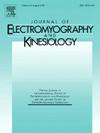Surface electromyography for characterizing neuromuscular changes in diabetic peripheral neuropathy
IF 2.3
4区 医学
Q3 NEUROSCIENCES
引用次数: 0
Abstract
Purpose
Distal symmetric polyneuropathy (DSP) is the most common diabetic neuropathy (75% of all diabetic neuropathies), potentially leading to plantar ulcers and lower limb amputation. Early detection of at-risk individuals is essential for timely intervention. This study aimed to evaluate different surface EMG (sEMG) parameters from isometric and dynamic exercises as biomarkers for early DSP detection and monitoring.
Methods
The study involved 61 participants (34 controls and 27 cases with low, moderate and high levels of severity). sEMG signals were recorded from four lower-limb muscles (tibialis anterior, medial gastrocnemius, extensor digitorum brevis, and flexor digitorum brevis) and characterized by their amplitude, frequency, complexity and shape.
Results
Significant sEMG differences were found between controls and diabetic patients at low and moderate/high DSP risk, especially in the extensor digitorum and flexor digitorum muscles during isometric and dynamic exercises. Diabetic patients showed lower amplitude and complexity, with higher frequency, peakedness, and asymmetry.
Conclusion
Parameters like root mean square, sample entropy, and central shape distance effectively distinguished between groups, highlighting changes in motor unit recruitment and muscle quality. Dynamic and isometric exercises emphasized their complementary roles in assessing muscle function, supporting sEMG’s potential as a non-invasive tool for monitoring neuromuscular changes in diabetes.
表面肌电图表征糖尿病周围神经病变的神经肌肉变化
目的远端对称多神经病变(DSP)是最常见的糖尿病神经病变(占所有糖尿病神经病变的75%),可能导致足底溃疡和下肢截肢。早期发现高危人群对于及时干预至关重要。本研究旨在评估来自等长运动和动态运动的不同表面肌电信号(sEMG)参数作为早期DSP检测和监测的生物标志物。方法共纳入61例患者(对照组34例,低、中、重度27例)。记录4块下肢肌肉(胫前肌、腓肠肌内侧肌、趾短伸肌和趾短屈肌)的肌电信号,并对其振幅、频率、复杂性和形状进行表征。结果低、中/高DSP风险的糖尿病患者与对照组之间的表面肌电信号有显著差异,特别是在等长运动和动态运动时的指伸肌和指屈肌。糖尿病患者的振幅和复杂性较低,频率、峰值和不对称性较高。结论均方根、样本熵、中心形状距离等参数能有效区分各组,突出运动单位招募和肌肉质量的变化。动态和等长运动强调了它们在评估肌肉功能方面的互补作用,支持肌电图作为监测糖尿病神经肌肉变化的非侵入性工具的潜力。
本文章由计算机程序翻译,如有差异,请以英文原文为准。
求助全文
约1分钟内获得全文
求助全文
来源期刊
CiteScore
4.70
自引率
8.00%
发文量
70
审稿时长
74 days
期刊介绍:
Journal of Electromyography & Kinesiology is the primary source for outstanding original articles on the study of human movement from muscle contraction via its motor units and sensory system to integrated motion through mechanical and electrical detection techniques.
As the official publication of the International Society of Electrophysiology and Kinesiology, the journal is dedicated to publishing the best work in all areas of electromyography and kinesiology, including: control of movement, muscle fatigue, muscle and nerve properties, joint biomechanics and electrical stimulation. Applications in rehabilitation, sports & exercise, motion analysis, ergonomics, alternative & complimentary medicine, measures of human performance and technical articles on electromyographic signal processing are welcome.

 求助内容:
求助内容: 应助结果提醒方式:
应助结果提醒方式:


